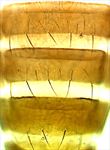
Female

Female

Male

Antenna

Head & pronotum

Meso & metanotum

Tergites VII–VIII

Tergites VII–IX

Sternites III–VII

Fore wing
Distinguishing features
Female macroptera. Body brown, head and thorax paler than abdomen, head commonly with cheeks darker than median area; legs mainly yellow; antennal segment III yellow, also basal half of IV–V; fore wings brown with base sharply pale. Antennae 7-segmented, III–IV constricted at apex, VII small. Head wider than long, ocellar setae pair III small and arising on anterior margins of triangle; postocular setae pairs I & III slightly longer than ocellar setae III, pair II minute. Pronotum posterior margin with 3 pairs of setae. Metanotum reticulate medially, reticles varying in shape and sometimes with faint internal markings; median setae long and arising behind anterior margin; campaniform sensilla absent. Fore wing first and second veins with complete rows of setae; clavus with 5 marginal setae. Tergite II with 3 lateral marginal setae; posterior margin of tergite VIII with comb almost absent, a few microtrichia present laterally; pleurotergites without discal setae. Sternites II & VII without discal setae, III–VI with about 6 to 12 discal setae in an irregular row.
Male macroptera. Body mainly or entirely yellow; tergite VIII with no posteromarginal comb; sternites III–VII each with small transverse pore plate, discal setae arising laterally.
Related species
There are 33 species of Thrips genus known from Australia (Mound & Masumoto, 2005), out of a total of 296 species worldwide (ThripsWiki, 2020). Many of these species have the antennae clearly 7-segmented, whereas others have 8 segments. Some species have two complete rows of setae on the fore wing veins, whereas others have the setal row on the first vein more or less widely interrupted. Moreover, some species have sternal discal setae, whereas other species have only marginal setae on the sternites. Despite this variation, all members of Thrips genus have paired ctenidia on the tergites, and on tergite VIII these are postero-mesad to the spiracles, and they also lack ocellar setae pair I in front of the first ocellus. In contrast, Frankliniella species have ctenidia on tergite VIII antero-lateral to the spiracles, and a pair of setae is always present in front of the first ocellus.T. parvispinus is closely related to T. orientalis, but that has the forewing uniformly shaded not pale at the base, and the metanotal sculptured reticles with more pronounced internal markings.
Biological data
Feeding and breeding in flowers and on leaves, and apparently attracted to scented white flowers such as Gardenia; apparently a minor pest in parts of Indonesia, and reported as causing damage to papaya crops in Hawaii, but there are no reports of significant damage to plants in Australia.
Distribution data
Widespread in South East Asia from Java to Taiwan, Timor and northern Australia as far south as Brisbane; also reported from southern Europe (Greece).
Family name
THRIPIDAE - THRIPINAE
Species name
Thrips parvispinus (Karny)
Original name and synonyms
Isoneurothrips parvispinus Karny, 1922: 106
Isoneurothrips jenseni Karny, 1925: 7
Isoneurothrips pallipes Moulton, 1928: 296
Thrips (Isoneurothrips) taiwanus Takahashi, 1936: 440.
References
Mound LA & Masumoto M (2005) The genus Thrips (Thysanoptera, Thripidae) in Australia, New Caledonia and New Zealand. Zootaxa 1020: 1–64. http://www.mapress.com/zootaxa/2005f/zt01020p064.pdf
Mound LA & Collins DW (2000) A south east Asian pest species newly recorded from Europe: Thrips parvispinus (Thysanoptera: Thripidae), its confused identity and potential quarantine significance. Journal of European Entomology 97: 197–200.